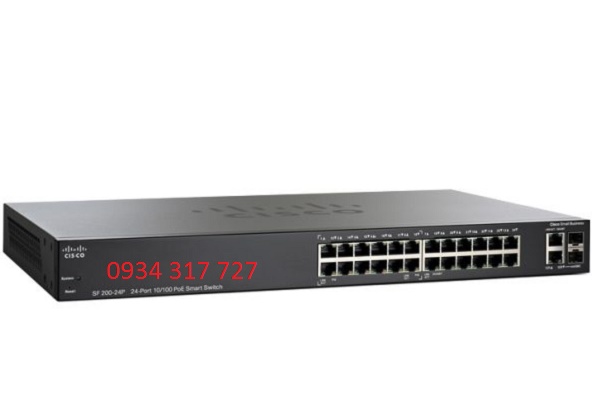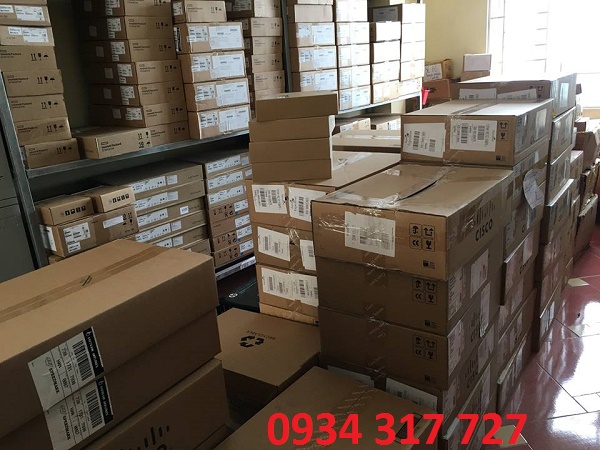Switch chia mạng Cisco 48Port 10/100Mbps PoE là một thiết bị quan trọng dùng để kết nối các đoạn mạng với nhau theo mô hình mạng hình sao (Star). Theo mô hình này, switch đóng vai trò là thiết bị trung tâm, tất cả các máy tính đều được nối về đây trong một hệ thống mạng

Switch chia mạng Cisco 48Port 10/100Mbps PoE là một thiết bị quan trọng dùng để kết nối các đoạn mạng với nhau theo mô hình mạng hình sao (Star). Theo mô hình này, switch đóng vai trò là thiết bị trung tâm, tất cả các máy tính đều được nối về đây trong một hệ thống mạng
Tính năng switch mạng Cisco 48Port 10/100Mbps PoE – Cisco SF200-48P
– Part number: SLM248PT-G5
– 48 cổng 10/100Mbps tự động chuyển chế độ cáp thẳng hoặc chéo (MDI/MDI-X). 02 Slot Mini GBit sử dụng các module MiniGbit SFP
– Hoạt động ở 2 chế độ half- or full-duplex cho mỗi cổng
– Thiết kế để bàn hoặc lắp trên tủ Rack
– Address Learning and Aging, and Data Flow Control giúp tối ưu truyền dữ liệu
– Nguồn điện: 110-240VAC, 50-60 Hz, internal
Cisco 48Port 10/100Mbps PoE hiệu suất cao và sử dụng công nghệ tiên tiến
– Hỗ trợ cho các công nghệ tiên tiến: Tất cả các thiết bị chuyển mạch Cisco bao gồm các tính năng giao thông xử lý tiên tiến để giữ cho các ứng dụng chạy ở hiệu suất cao điểm.
. Tích hợp QoS thông minh trên tất cả các mô hình tự động ưu tiên dịch vụ chậm trễ nhạy cảm như thoại hoặc video để cải thiện hiệu suất mạng.
. Fast store-and-forward switching xác định các gói tin bị hư hỏng và ngăn ngừa chúng khỏi bị truyền qua mạng. Tất cả những tính năng chạy tự động, không có quản lý hoặc cấu hình yêu cầu
– Cisco 48Port 10/100Mbps PoE – Cisco SF200-48P mang hiệu suất mà cao để chạy các ứng dụng viễn thông, bao gồm cả các dịch vụ video băng thông. Nâng cao công suất và hiệu suất truyền tải, cho phép bạn chuyển các tập tin lớn trong vài giây

Thông số kỹ thuật
Performance
Capacity in Mpps (64-byte packets): 10.12
Switching Capacity in Gbps: 13.6
Layer 2 Switching
Spanning Tree Protocol: Standard 802.1d STP support
Fast convergence using 802.1w (Rapid Spanning Tree), enabled by default
Port Grouping: Support for IEEE 802.3ad Link Aggregation Control Protocol
– Up to 8 groups
– Up to 4 ports per group with 16 candidate ports for each (dynamic) 802.3ad link aggregation
VLAN: Support for up to 128 VLANs simultaneously (out of 4096 VLAN IDs)
Port-based and 802.1Q tag-based VLANs
Voice VLAN: Voice traffic is automatically assigned to a voice-specific VLAN and treated with appropriate levels of QoS
Internet Group Management Protocol Versions 1 & 2 Snooping: Internet Group Management Protocol limits bandwidth-intensive multicast traffic to only the requesters; supports 256 multicast groups
Head-of-Line (HOL) Blocking: Head-of-line blocking
Security
IEEE 802.1X (Authenticator Role): RADIUS authentication and accounting, MD5 hash
Port Security: Locks MAC addresses to ports, and limits the number of learned MAC addresses
Storm Control: Broadcast, multicast and unknown unicast
Quality of Service
Priority Levels: 4 hardware queues
Scheduling: Strict priority and weighted round-robin
Queue assignment based on differentiated services code point and class of service (802.1p/CoS)
Class of Service: Port based, 802.1p VLAN priority based, IPv4/v6 IP precedence/type of service /DSCP based, Differentiated Services (DiffServ)
Rate Limiting: Ingress policer, per VLAN and per port
Standards
IEEE 802.3 10BASE-T Ethernet, IEEE 802.3u 100BASE-TX Fast Ethernet, IEEE 802.3ab 1000BASE-T Gigabit Ethernet, IEEE 802.3ad LACP, IEEE 802.3z Gigabit Ethernet, IEEE 802.3x Flow Control, IEEE 802.1D (STP), IEEE 802.1Q/p VLAN, IEEE 802.1w RSTP, IEEE 802.1X Port Access Authentication, IEEE 802.3af, RFC 768, RFC 783, RFC 791, RFC 792, RFC 793, RFC 813, RFC 879, RFC 896, RFC 826, RFC 854, RFC 855, RFC 856, RFC 858, RFC 894, RFC 919, RFC 922, RFC 920, RFC 950, RFC 951, RFC 1042, RFC 1071, RFC 1123, RFC 1141, RFC 1155, RFC 1350, RFC 1533, RFC 1541, RFC 1542, RFC 1624, RFC 1700, RFC 1867, RFC 2030, RFC 2616, RFC 2131, RFC 2132, RFC 3164, RFC 2618
IPv6
IPv6: IPv6 host mode
IPv6 over Ethernet
Dual IPv6/IPv4 stack
IPv6 neighbor and router discovery (ND)
IPv6 stateless address auto-configuration
Path maximum transmission unit discovery
Duplicate address detection
Internet Control Message Protocol Version 6
IPv6 over IPv4 network with Intra-Site Automatic Tunnel Addressing Protocol support
IPv6 QoS: Prioritize IPv6 packets in hardware
Multicast Listener Discovery Snooping: Deliver IPv6 multicast packets only to the required receivers
IPv6 Applications: Web, ping, Simple Network Time Protocol, Trivial File Transfer Protocol, RADIUS, syslog, DNS client
IPv6 RFCs Supported: RFC 2463: ICMP version 6
RFC 3513: IPv6 address architecture
RFC 4291: IPv6 addressing architecture
RFC 2460: IPv6 specification
RFC 2461: Neighbor discovery for IPv6
RFC 2462: IPv6 stateless address auto-configuration
RFC 1981: Path maximum transmission unit discovery
RFC 4007: IPv6 scoped address architecture
RFC 3484: Default address selection mechanism
RFC 4214: ISATAP tunneling
RFC 4293: MIB IPv6: Textual conventions and general group
RFC 3595: Textual conventions for IPv6 flow label
Management
Web User Interface: Built-in switch configuration utility for easy browser-based device configuration (HTTP) Supports configuration, system dashboard, system maintenance and monitoring
Remote Monitoring: Embedded RMON software agent supports one RMON group (statistics) for enhanced traffic management, monitoring, and analysis
IPv4 and IPv6 Dual Stack: Coexistence of both protocol stacks to ease migration
Firmware Upgrade: Web browser upgrade (HTTP) and TFTP
Port Mirroring: Traffic on a port can be mirrored to another port for analysis with a network analyzer or RMON probe Up to 4 source ports can be mirrored to one destination port. A single session is supported
VLAN Mirroring: Traffic from a VLAN can be mirrored to a port for analysis with a network analyzer or RMON probe Up to 4 source VLANs can be mirrored to one destination port. A single session is supported
Dynamic Host Configuration Protocol (Options 66 and 67): Dynamic Host Configuration Protocol options facilitate tighter control from a central point (DHCP server) to obtain IP address, auto-configuration (with configuration file download)
Text-Editable Config Files: Config files can be edited with a text editor and downloaded to another switch, facilitating easier mass deployment
Smartports: Simplified configuration of QoS and security capabilities
Cloud Services: Support for FindIT Network Discovery Utility
Localization: Localization of GUI and documentation into multiple languages
Other Management: HTTP, RADIUS, port mirroring, TFTP upgrade, DHCP client, BOOTP, SNTP, ping, syslog
Power Efficiency Energy Detect: Automatically turns off power on Gigabit Ethernet RJ-45 port when the switch detects a link down
Active mode is resumed without loss of any packets when the switch detects the link is back up
Cable Length Detection: Adjusts the signal strength based on the cable length. Reduces the power consumption for cables shorter than 10 m
MAC Table: Up to 8000 MAC addresses
Discovery
Link Layer Discovery Protocol (802.1ab) with LLDP-MED extensions: Link Layer Discovery Protocol allows the switch to advertise its identification, configuration, and capabilities to neighboring devices, which store the data in an MIB. LLDP-MED is an enhancement to LLDP that adds the extensions needed for IP phones
Cisco Discovery Protocol: The switch advertises itself using the Cisco Discovery Protocol
Power Over Ethernet
Power Dedicated to PoE: 180W
Number of Ports That Support PoE: 24
Power Consumption
Power Savings Mode: Energy Detect
Power Consumption Worst Case: 110V/0.355A/37.2W
220V/0.217A/37.4W
Heat Dissipation (BTU/hr): 127.6
Ports
48 10/100 Fast Ethernet RJ-45 Ports
2 Gigabit Ethernet combo mini-GBIC ports (RJ-45 + SFP) 1
Buttons
Reset button
Cabling Type
Unshielded twisted pair Category 5 or better for 10BASE-T/100BASE-TX; UTP Category 5 Ethernet or better for 1000BASE-T
LEDs
System, Link/Act, PoE, Speed
Flash
16 MB
CPU
128 MB memory
Packet Buffer Memory
2 @ 8 MB
Power Supply
100V-240V, 50V/3.6A, 12V/4A, 50-60 HZ
Fan
2
Acoustic Noise
41.7 dB
MTBF
@ 40°C (hours): 174,966
Certifications
UL (UL 60950), CSA (CSA 22.2), CE mark, FCC Part 15 (CFR 47) Class A
MINIMUM REQUIREMENTS
Web browser: Mozilla Firefox version 2.5 or later; Microsoft Internet Explorer version 6 or later
Category 5 Ethernet network cable
TCP/IP, network adapter, and network operating system (such as Microsoft Windows, Linux, or Mac OS X) installed on each computer in the network
Dimensions (DxWxH)
13.8 x 17.35 x 1.74′ (350 x 440 x 44.19 mm)
Weight
10.43 lb (4.73 kg)